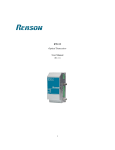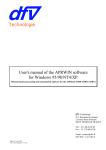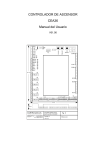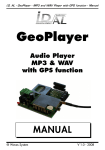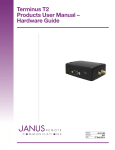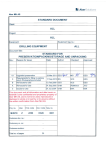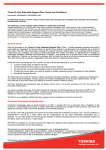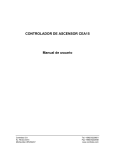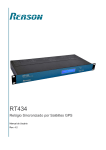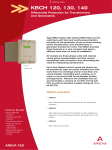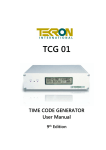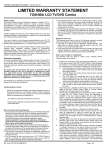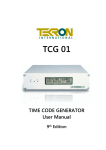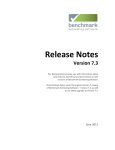Download Alstom Reason RT412 Manual GB
Transcript
Reason RT412 Technical Manual Optical Transceiver Platform Hardware Version: A Publication Reference: RT412-TM-EN-2 © ALSTOM 2014. All rights reserved. Information contained in this document is indicative only. No representation or warranty is given or should be relied on that it is complete or correct or will apply to any particular project. This will depend on the technical and commercial circumstances. It is provided without liability and is subject to change without notice. Reproduction, use or disclosure to third parties, without express written authority, is strictly prohibited. Optical Transceiver Contents TECHNICAL MANUAL 1 PREFACE 4 ACRONYMS AND ABBREVIATIONS 5 1. DESCRIPTION 8 1.1 INTRODUCTION 8 1.2 FOREWORD 8 1.3 KEY FEATURES 8 1.4 FRONT AND SIDE VIEW 9 1.5 POWER SUPPLY 11 1.6 ELECTRICAL INPUT 12 1.7 OPTICAL INPUT 12 1.8 ELECTRICAL OUTPUTS 12 1.9 OPTICAL OUTPUTS 13 1.10 ENVIRONMENT 13 1.11 WEIGHT AND DIMENSIONS 14 2. INSTALLATION 15 2.1 UNPACKING 15 2.2 EXTERNAL INDICATIONS 15 2.3 ENVIRONMENT 16 2.4 MOUNTING 16 2.5 CONNECTORS 16 2.6 POWER SUPPLY 18 2.6.1 AC POWER CONNECTION 19 2.6.2 DC POWER CONNECTION 19 2.7 POWERING UP 20 2.8 ELECTRICAL INPUT 20 2.9 OPTICAL OUTPUT 21 2.10 JUMPER TO SELECT INPUT 21 2.1 ELECTRICAL OUTPUTS 22 2.2 OPTICAL OUTPUT 23 2.3 STATUS INDICATORS 23 2 RT412-TM-EN-2 RT412 3. MAINTENANCE 24 3.1 SYNCHRONISM FAILURE 24 3.1.1 POWER SUPPLY FAILURE 24 3.1.1 CLEANING INSTRUCTIONS 24 3.1.2 RETURNING A UNIT 25 APPENDIX A - CORTEC 26 APPENDIX B - IRIG-B STANDARD SUMMARY 27 RT412-TM-EN-2 3 Optical Transceiver PREFACE © 2014 Alstom. All rights reserved. Products developed by Alstom are continuously improved. The information this document contains reflects this improvement, and for this Alstom it is subject to change without notice. Please make sure that this is latest version of this document before proceeding. All specifications are subject to changes without prior notice. Certification to the the ISO 9001:2008 quality standard is an example of this commitment. We encourage and appreciate any feedback and will use it to improve our products and services. 4 RT412-TM-EN-2 RT412 ACRONYMS AND ABBREVIATIONS AC - Alternating Current; ACEB NEMEA - Acronyms and Abbreviations; ASCII - American Standard Code for Information Interchange; BMC - Best Master Clock; BNC - Bayonet Neil Concelman connector; Bps – Bytes per second; bps - Bits per second; CAT5 - Network Cable; CF - Federal Constitution; PLC – Programmable Logic Controller; CMOS - Complementary Metal-Oxide-Semiconductor; CR2032 - Lithium battery model; DB9 - Conector do tipo D-subminiature; DC - Direct Current; DCF77 - Time synchronism protocol Deutschland LORAN-C (Long Range Navigation - C) Frankfurt 77 (77,5 kHz); DNS - Domain Name System; DTE - Data Terminal Equipment; E2E - End-to-end; ETH - Abbreviation of the term Ethernet; FW - Abbreviation of the term Firmware; GND - Abbreviation of the term Ground; RT412-TM-EN-2 5 Optical Transceiver GPS - Global Positioning System; GPZDA - Serial Datagram format; HTTP - Hypertext Transfer Protocol; HTTPS - Hypertext Transfer Protocol Secure; IEC - International Electrotechnical Commission; IED - Intelligent Electronic Devices; IEEE - Institute of Electric and Electronic Engineers; IHM - Human-Machine Interface; IP - Internet Protocol; IP40 - Degree of protection 40; IRIG-B - Time synchronism protocol Inter Range Instrumentation Group (Rate Designation B); LCD - Liquid Crystal Display; MAC - Media Access Control; NTP - Network Time Protocol; OUT - Abbreviation of the term Output; P2P - Peer-to-peer; PLC- Programmable Logic Controller; PPM - Pulse per minute; PPS - Pulso por Segundo; PPX - Pulso por X s; PTP - Precision Time Protocol; RFC - Data formatting specification RFC 1951, DEFLATE; RJ45 - Conector para rede Ethernet com 8 condutores; RS232/485 - Serial port levels; 6 RT412-TM-EN-2 RT412 RT - Temporal Recorder (Alstom's Temporal Synchronism Equipment); RX - Receiving data; SNMP - Simple Network Management Protocol; SNTP - Simple Network Time Protocol; ST - Bayonet-lock connector; TCP - Transmission Control Protocol; TMARK - Daily pulses with programmable time; TTL - Transitor-to-Transitor logic; TX - Data transmission; UDP - User Datagram Protocol; UTC - Universal Time Coordinate. RT412-TM-EN-2 7 Optical Transceiver 1. DESCRIPTION 1.1 Introduction RT412 - Optical Transceiver is an electrical-optical and optical-electrical converter. It converts signals into pulsed signals for time synchronism. Also, the features allow multiplying the outputs of GPS clocks. The equipment has optical or electrical input, selectable by the user. Also, it has two TTL-level electrical outputs and an optical output. It accepts IRIG-B signals or any other frequency signal (1PPS, 100PPS, 1PPM,inter alia). The power supply is full range integrated. The delay of the output signal in relation to the input is under 100 ns. This User Manual is structured as follows: Chapter 1 presents RT412 descriptions, its applications, technical specifications, and how the manual is presented. Chapter 2 presents how RT412 should be installed, considering power supply, cables connections, synchronism outputs,inter alia. 1.2 Foreword This technical manual provides a functional and technical description of Alstom Grid's RT412, as well as a comprehensive set of instructions for using the device. We have attempted to make this manual as accurate, comprehensive and user-friendly as possible. However we cannot guarantee that it is free from errors. Nor can we state that it cannot be improved. We would therefore be very pleased to hear from you if you discover any errors, or have any suggestions for improvement. All feedback should be sent to our contact centre via the following URL: http://www.alstom.com/grid/contactcentre/ 1.3 8 Key Features 100 ns accuracy; RT412-TM-EN-2 RT412 Integrated optical-electrical and electrical-optical converter; ST connector optical Input; Time signals in IRIG-B00x format; Pulses: 100 pulses-per-second, 1 pulse-per-second, 1 pulse-per-minute and low frequency pulses; 2 electrical outputs with screw connector with an individual supply capacity up to 100 mA; 1 optical output with ST connector and multimode fiber. Indicators for monitoring the input signal of time synchronism and the presence of primary supply; DIN rail mounting; AC or DC power supply sources. 1.4 Front and Side View The front panel of the RT412 presents its identification, model, and a label with Serial Number and Part Number. Figure 1 shows the front view of the equipment. RT412-TM-EN-2 9 Optical Transceiver FIGURE 1: RT412 FRONT VIEW Figure 2 shows the components of the side panel FIGURE 2: RT412 SIDE VIEW 10 RT412-TM-EN-2 RT412 The side panel of the RT412 comprises one feeding input, AC or DC; two electrical outputs with TTL-level screw connector; an electrical input; a jumper to select the input type; an optical input and output; synchronism signal and power supply indicators. For information on installing the unit, see Chapter 2. 1.5 Power Supply TABLE 1.1: POWER SUPPLY SPECIFICATIONS Operating voltage range 80–275 V d.c., 88–264 V a.c. Frequency 50/60 Hz _3 Hz Consumption < 3 VA RT412-TM-EN-2 11 Optical Transceiver 1.6 Electrical Input TABLE 1.2: ELECTRICAL INPUT SPECIFICATIONS Connectors (2) Screw High Level 4.2 V Low Level 9.8 V Impedance > 500 1.7 Optical Input TABLE 1.3: OPTICAL INPUT SPECIFICATION Wave Length 820 nm Fiber Type multimode 50/125 µm, 62.5/125 µm 100/140 µm or 200 µm HCS Connector ST Sensibility -24 dBm 1.8 Electrical Outputs TABLE 1.3: ELECTRICAL OUTPUTS SPECIFICATIONS 12 Conectors (4) Screw (2 outputs) High Level 1 > 4 V d.c. Low Level 2 < 0.2 V d.c. RT412-TM-EN-2 RT412 Impedance > 500 Current 100 mA (for 2 outputs) 1.9 Optical Outputs TABLE 1.3: OPTICAL OUTPUTS SPECIFICATIONS Wave Length 820 nm Fiber Type 50/125 µm, 62.5/125 µm, 100/140 µm or 200 µm HCS multimode. Connector ST Transmission Powere -17.8 dBm (50/125 µm) -14.0 dBm (62.5/125 µm) -8.5 dBm (100/140 µm) -5.7 dBm (200 µm HCS) 1.10 Environment TABLE 1.6 ENVIRONMENT SPECIFICATIONS Operating temperature +5 . . . +55 °C Enclosure protection IP40 Relative humidity 5 . . .95% (noncondensing) Maximum Altitude 2000 m (6560 ft) RT412-TM-EN-2 13 Optical Transceiver 1.11 Weight and Dimensions TABLE 1.6 WEIGHT AND DIMENSIONS SPECIFICATIONS Height 117 mm Width 51 mm Depth 95 mm Weight 1 Kg RT412 dimensions are shown in Figure 3. FIGURE 3: RT412 DIMENSIONS 14 RT412-TM-EN-2 RT412 2. INSTALLATION 2.1 Unpacking Unpack the unit carefully and make sure all the accessories and cables are put aside so they will not be lost. Check the contents against the packing list that goes with the product. If any of the content listed are missing, please contact Alstom (see contact information at the beginning of this manual). Examine the unit for any shipping damage. If the unit is damaged or fails to operate, notify the shipping company without delay. Only the consignee (the person or company receiving the unity) can file a claim against the carrier for shipping damage. We recommend you keep the original packing materials for eventual future transport. 2.2 External Indications The serial number and part number are shown on a label fixed on the side of the unit, as shown in figure 4. Figure 4: Location of Serial number and Part Number RT412-TM-EN-2 15 Optical Transceiver 2.3 Environment Temperature and relative humidity should not exceed the limits stated in Chapter 1. We recommend providing appropriate heating or cooling measures to ensure that these limits are respected at all times. 2.4 Mounting RT412 has been designed to be mounted on DIN rails. A support bracket, must be used. Support bracket to assemble the unit on DIN rails For more information about dimensions of the unit, see Chapter 1. 2.5 Connectors Components and connectors of RT412’s rear panel are shown in figure 5. 16 RT412-TM-EN-2 RT412 Figure 5: Rear panel connectors TABLE 2.1: Connectors on the rear panel of the equipment.. Indicator Description A Optical output; B 2 screw connector electrical outputs for synchronism; a jumper to select the type of input; an electrical input for synchronism; C Optical input; The ACT indicator will light upas soon as signal of one of the synchronism inputs is detected. D The POWER indicator will light up if a primary power supply is connected to the unit. E RT412-TM-EN-2 AC or DC inputs; 17 Optical Transceiver 2.6 Power Supply RT412 has been designed to be mounted in a standard 19-inch rack using four M6x15 screws to affix. Allow adequate clearance for all connections. All power connections should use insulated flameproof flexible cable (BWF type) with a 1.5 mm² cross section, 70°C thermal class, and 750V insulation voltage. To reduce the risk of electrical shock, pre-insulated tubular pin terminals should be used on the ends of the power connections. Figure 6: Pre-insulated tubular pin terminals The pin terminals should be completely inserted into the connector supplied with the unity so that no metallic parts are exposed, according to the figure 7. Figure 7:Supply connector assembly A 1.5 mm² ground lead shall be connected to the terminal marked with the protective earth symbol for safety. For optimal electromagnetic compatibility, ground the unit by using a 10mm wide grounding strap to connect the rear panel of the unit to a good ground point on the mounting rack. 18 RT412-TM-EN-2 RT412 2.6.1 AC Power Connection Positive should be applied to terminal +/L, negative to terminal -/N in each of the supply terminals identified as Power 1 and Power 2 as shown in figure 8. Figure 8: AC power connection Installation of an external 10 A, category C, bipolar circuit breaker near the unit is recommended. The circuit breaker should have an interruption capacity of at least 25 kA and comply with IEC 60947-2 standard. 2.6.2 DC Power Connection Positive should be applied to terminal +/L, negative to terminal -/N in each of the supply terminals identified as Power 1 and Power 2 as shown in figure 9. Figure 9: DC power connection RT412-TM-EN-2 19 Optical Transceiver Installation of an external 10 A, category C, bipolar circuit breaker near the unit is recommended. The circuit breaker should have an interruption capacity of at least 25 kA and comply with IEC 60947-2 standard. 2.7 Powering Up Before energizing the unit, be familiarized with all the risk and attention indicators in the equipment frame; Connect the power supply (including the ground lead) to the appropriate terminals. The unit performs a self-test procedure, and the ALARM indicator will remain lit. At the end of the self-test, the equipment will perform initialization of the GPS receiver. At the end of approximately one minute the ALARM indicator will go out and information will be shown in the equipment's display. To turn off the unit, disconnect the power supply (including the ground lead) from the terminals. The unit will record the time, date, satellite orbits parameters, and internal oscillators drift estimates in non-volatile memory to improve accuracy and reduce the time to synchronize with satellites in the next energizing process. Also, all front panel indicators will turn off. In case the unit does not behave in a way here described, carefully check all power and signal connections. See chapter 6 for additional suggestion for problem diagnosis. 2.8 Electrical Input RT412 has an electrical input with screw connector, to be used as electrical-optical converter, identified as ELECTRICAL SIGNAL INPUT, as shown in Figure; 20 RT412-TM-EN-2 RT412 Figure 10: TTL level electrical input The input accepts demodulated IRIG signals, 1PPS, 1PPM, 100PPS, or low frequency pulses. The signal inserted in the selected input is sent to the electrical and optical outputs. 2.9 Optical Output RT412 has an optical input with BNC connector, to be used as optical-electrical converter, identified as OPTICAL INPUT, as shown in figure 13. Figure 11: Optical Input The input accepts demodulated IRIG signals, 1PPS, 1PPM, 100PPS, or low frequency pulses. The signal inserted in the selected input is sent to the electrical and optical outputs. Connection Diagrams of the Synchronism Inputs 2.10 Jumper to Select Input RT412 can be used with an optical or electrical input. To select the type of input desired, the following logic must be used as shown in figure 18. RT412-TM-EN-2 21 Optical Transceiver Table 2.1: Jumper to select the input Closed Jumper Electrical Input Open Jumper Optical Input The jumper to select the input is identified as CLOSE TO SELECT ELECTRICAL INPUT. Figure 12: Jumper to select the input 2.1 Electrical Outputs RT412 has 2 screw connector electrical outputs, identified as OUT 1 and OUT 2, Figure 14: TTL Level electrical outputs The synchronism signal inserted in the selected input is sent to the electrical and optical outputs. 22 RT412-TM-EN-2 RT412 2.2 Optical Output RT412 has 1 BNC connector optical output, identified as OPTICAL OUTPUT; Figure 15: Optical output The synchronism signal inserted in the selected input is sent to the electrical and optical outputs. 2.3 Status Indicators RT412 has status indicators for monitoring the presence of primary supply and data flow between the synchronism input and output, Figure 16: RT412 Status Indicators The POWER indicator will light up as soon a primary power supply is connected to the unit. In case the power supply is interrupted, the indicator will turn off. The ACT indicator, when lit, indicates data flow between the input and output. RT412-TM-EN-2 23 Optical Transceiver 3. MAINTENANCE 3.1 Synchronism Failure When the unit is operating without data flow between the input and output, the ACT indicator will remain off. Every time synchronism failure is detected, the following actions are recommended: Make sure the unit is turned on. Make sure the electrical or optical-fiber cables are connected properly. Make sure the receipt and transmission connectors are not changed. Make sure the input configuration (Jumper) is correct. Make sure the electrical or optical-fiber cables are in good conditions. If possible, do the test using another electrical or optical-fiber cable. Make sure the optical-fiber cable is according to the specifications established. Make sure the power supply terminal is connected properly; Make sure there is voltage at the terminals. 3.1.1 Power Supply Failure If there is no power supply, the POWER indicator will remain off. When there is voltage failure, the following actions are recommended: Make sure the terminals 1, 2 and Ground are connected properly. Make sure there is voltage in the power supply terminal. 3.1.1 Cleaning Instructions Before cleaning the equipment, make sure that the primary voltage is removed. If it is necessary cleaning the exterior of the equipment, use only a dry cloth. Internally it is not required any cleaning. 24 RT412-TM-EN-2 RT412 3.1.2 Returning a Unit In case repair service is needed, contact Alstom to check out the shipment options and receive a technical assistance reference code. To contact Alstom, see the Contact section of this manual. The equipment shall be packed in its original package or a suitable package to protect against impacts and moisture. Identify the package with the technical assistance code and send it to the address supplied. RT412-TM-EN-2 25 Optical Transceiver APPENDIX A - CORTEC Variants Model Type RT412 Optical Transceiver Power Supply 110-250 Vdc / 100-240 Vac Customization / Regionalisation Default Reason branding Hardware Design Suffix Initial release 26 Order Number 1-5 6 7 8 RT412 3 A B A RT412-TM-EN-2 RT412 APPENDIX B - IRIG-B STANDARD SUMMARY IRIG-B004 and IRIG-B124 Content Table A.1: IRIG-B standard summary. 0 reference bit ( ) 1 + 10 ms seconds 1 2 + 20 ms seconds 2 3 + 30 ms seconds 4 4 + 40 ms seconds 8 5 + 50 ms index bit (0) 6 + 60 ms seconds 10 7 + 70 ms seconds 20 8 + 80 ms seconds 40 9 + 90 ms position identifier 1 ( ) 10 + 100 ms minutes 1 11 + 110 ms minutes 2 12 + 120 ms minutes 4 13 + 130 ms minutes 8 14 + 140 ms index bit (0) RT412-TM-EN-2 seconds (0 ... 59 or 60) minutes (0 ... 59) 27 Optical Transceiver 15 + 150 ms minutes 10 16 + 160 ms minutes 20 17 + 170 ms minutes 40 18 + 180 ms index bit (0) 19 + 190 ms position identifier 2 ( ) 20 + 200 ms hours 1 21 + 210 ms hours 2 22 + 220 ms hours 4 23 + 230 ms hours 8 24 + 240 ms index bit (0) 25 + 250 ms hours 10 26 + 260 ms hours 20 27 + 270 ms index bit (0) 28 + 280 ms index bit (0) 29 + 290 ms position identifier 3 ( ) 30 + 300 ms days 1 31 + 310 ms days 2 32 + 320 ms days 4 33 + 330 ms days 8 28 hours (0 ... 23) day of the year (1 ... 365 or 366) RT412-TM-EN-2 RT412 34 + 340 ms index bit (0) 35 + 350 ms days 10 36 + 360 ms days 20 37 + 370 ms days 40 38 + 380 ms days 80 39 + 390 ms position identifier 4 ( ) 40 + 400 ms days 100 41 + 410 ms days 200 42 + 420 ms index bit (0) 43 + 430 ms index bit (0) 44 + 440 ms index bit (0) 45 + 450 ms index bit (0) 46 + 460 ms index bit (0) 47 + 470 ms index bit (0) 48 + 480 ms index bit (0) 49 + 490 ms position identifier 5 ( ) 50 + 500 ms year 1 51 + 510 ms year 2 52 + 520 ms year 4 RT412-TM-EN-2 The last 2 digits of the year (00 ... 99) 29 Optical Transceiver 53 + 530 ms year 8 54 + 540 ms index bit (0) 55 + 550 ms year 10 56 + 560 ms year 20 57 + 570 ms year 40 58 + 580 ms year 80 59 + 590 ms position identifier 6 ( ) 60 + 600 ms index bit (0) 61 + 610 ms index bit (0) 62 + 620 ms Daylight Saving Pending (DSP) 1 during the minute before beginning or end of DST 63 + 630 ms Daylight Saving Time (DST) 1 during DST 64 + 640 ms Time Offset Sign (0=+, 1=-) difference between local time and UTC (negative for West Greenwich) 65 + 650 ms Time Offset 1 difference between local time and UTC 66 + 660 ms Time Offset 2 (-12 ... +12) 67 + 670 ms Time Offset 4 68 + 680 ms Time Offset 8 69 + 690 ms position identifier 7 ( ) 70 + 700 ms Time Offset /2 30 RT412-TM-EN-2 RT412 71 + 710 ms Time Quality 0000 (0) : locked 72 + 720 ms Time Quality 1111 (F) : no-time 73 + 730 ms Time Quality 1011 (B) : never locked 74 + 740 ms Time Quality 0100 (4) : free-wheeling 75 + 750 ms Parity (odd) Módulo 2 of the sum of the data bits 0 a 74 (Bits 75-99 not included in the sum) 76 + 760 ms index bit (0) 77 + 770 ms index bit (0) 78 + 780 ms 79 + 790 ms 80 + 800 ms 81 + 810 ms 82 + 820 ms 83 + 830 ms 84 + 840 ms 85 + 850 ms 86 + 860 ms 87 + 870 ms 88 + 880 ms 89 + 890 ms RT412-TM-EN-2 index bit (0) position identifier 8 ( ) time-of-day 1 seconds of the year time-of-day 2 (0 ... 86399 or 86400) time-of-day 4 time-of-day 8 time-of-day 16 time-of-day 32 time-of-day 64 time-of-day 128 time-of-day 256 position identifier 9 ( ) 31 Optical Transceiver 90 + 900 ms 91 + 910 ms 92 + 920 ms 93 + 930 ms 94 + 940 ms 95 + 950 ms 96 + 960 ms 97 + 970 ms 98 + 980 ms 99 + 990 ms 32 time-of-day 512 time-of-day 1024 time-of-day 2048 time-of-day 4096 time-of-day 8192 time-of-day 16384 time-of-day 32768 time-of-day 65536 index bit (0) position identifier 0 ( ) RT412-TM-EN-2 RT412 RT412-TM-EN-2 33 Optical Transceiver Alstom Grid © ALSTOM 2014. All rights reserved. Information contained in this document is indicative only. No representation or warranty is given or should be relied on that it is complete or correct or will apply to any particular project. This will depend on the technical and commercial circumstances. It is provided without liability and is subject to change without notice. Reproduction, use or disclosure to third parties, without express written authority, is strictly prohibited. Alstom Grid Worldwide Contact Centre www.alstom.com/grid/contactcentre/ Tel: +44 (0) 1785 250 070 www.alstom.com 34 RT412-TM-EN-2


































